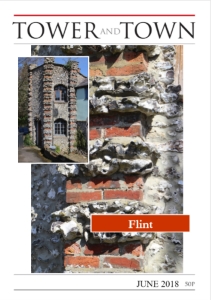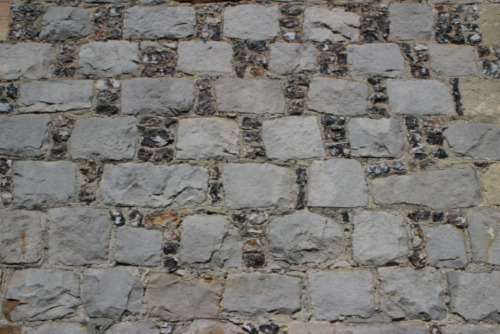

Tower and Town, June 2018 (view the full edition) (view the full edition)Building With FlintFlint is a very hard form of the mineral quartz. Layers of flint nodules are found abundantly within the very soft limestone known as chalk. Here in Marlborough we are in one of the most extensive areas of chalk in England and as it is very easily eroded, nodules of flint of all sizes readily appear at the surface. These nodules are a dirty white on the exterior, but they can be broken open to reveal a grey, pearly and glassy interior. The very special properties of flint have been known since the Stone Age, when early man discovered that flint could be chipped to produce hard and very sharp splinters which made excellent tools. As flint is very hard and chemically inert, it has been used as the building material of choice throughout the chalk country of southern and eastern England since very early times. Not only is it found beneath your feet, and therefore readily available, but there is a distinct lack of better building materials here. You need to look to the Bath stone quarries in the Corsham area, or to Chilmark, west of Salisbury, to find good building stone; a very expensive option in Medieval times. Fortunately Marlborough has been blessed with local supplies of a hard crystalline sandstone , known locally as sarsen which has been a valuable supplement to the flint. Building with flints is a very skilful operation. The flints themselves are usually split open or ‘knapped’ to produce a hard and smooth surface, ideal for walls. Sometimes the small round flint ‘cobbles’ of matching size are laid in rows and set in place with lime mortar. However a more satisfying result can be achieved by using ‘knapped’ flints; nodules that have been split open to reveal the dark and glassy surfaces which are so familiar. These can be laid in carefully graded layers or even in patterns, such as ‘herringbone’. However, it is difficult to make a clean and resistant edge to a flint wall, so you will find that the corners are often ‘quoined’ in brick or dressed stone, as are door and window frames. This contrast in colour and texture is what makes flint buildings so attractive. Flint garden walls also need some protection from the weather. So they are often capped with clay tiles or even thatch since rainwater would soon dissolve away the lime mortar. In the Marlborough area it was common practice to build the flint houses on a platform of solid dressed sarsen stones, readily available on the Downs.  Where there was an even greater shortage of stone the problem of weathering was resolved by building circular church towers, so there were not exposed edges. One such local circular church tower is at Welford in the Lambourn valley north of Newbury, where a very early and ruinous circular tower was rebuilt in the 19th century. Quite frequently flint was used in partnership with other materials, a style called ‘flushwork’. Sometimes a couple of rows of brick divide up the flint wall, or brick columns are used like ‘fencing posts’. However the most sophisticated flushwork flint buildings lie in the Avon valley between Amesbury and Salisbury where houses great and small used blocks of Chilmark stone and panels of flint work to create attractive chequer designs. You can see local examples in Preshute church or West Overton where sophisticated patterns have been created from the dressed sarsen stones and flint. In the late 18th and early 19th centuries, flint was used extensively on country estates to create ‘quaint’ or ‘rustic’ lodges and even toll houses. 58 George Lane is a very fine example. Here the original flint cottage appears to be octagonal with the corners supported with flint and brick layered buttresses. It must have once been a very ‘picturesque’ sight. Look around you; flint is very much part of the Marlborough built environment. Chris Rogers |